Well, I have no idea how I did this, but I somehow managed to read 11 books in July! Some I have reviewed here, but many I have not, so I figured I’d go through them all and offer up a few thoughts on each.

On July 1st, I finished Blood Moon: An American Epic of War and Splendor in the Cherokee Nation by John Sedgwick. It took me a long time to get through this book, but I’m so glad I read it. While the narrative was slow at times, I learned so much that it made up for the slow pace. The title gives a good description of this book, which chronicles the rise and fall of the Cherokee Nation as Europeans settled in North America, formed the United States, and began to encroach on their land. Sedgwick focuses on the feud between Major Ridge and John Ross, two influential Cherokee leaders who had drastically different views on how the Cherokee Nation could fit into the newly created United States. Sedgwick breaks down the complex history of the Cherokee Nation into digestible portions, while maintaining a high level of detail. I highly recommend this book to anyone interested in learning more about the Cherokee and early United States history!
Next, I completed The Great Alone by Kristin Hannah, which I reviewed here. Overall, I thought this was another good novel by Hannah. The story was compelling and kept me reading, but I didn’t find it to be anything special or outstanding. You can check out my review here for a more detailed breakdown.
I then finished Do Not Say We Have Nothing by Madeleine Thein. I had high expectations for this book, since I’ve been wanting to read it for a long time, and I was’t let down–I really really loved this book! Do Not Say We Have Nothing tells the story of a family through two generations, who lived during a tumultuous time in China after Mao took power. The story centers on Marie, a young girl at the beginning of the novel, whose father has just committed suicide after he disappeared back to China, leaving Marie and her mother alone in Vancouver. After her father’s friend’s daughter, Ai-ming, comes to stay with Marie and her mother, Marie becomes obsessed with learning about her father’s history, and his connection to Ai-ming’s father. Thein weaves present and past together beautifully, switching from Marie’s story to that of her father and Ai-ming’s father. Do Not Say We Have Nothing is a beautiful exploration of friendship, family, independence, and revolution–both political, and personal.
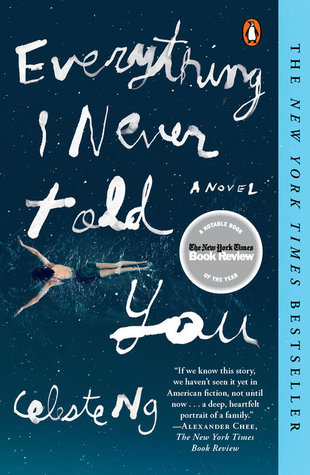 Everything I Never Told You by Celeste Ng was my next read in July. Since finishing Ng’s second novel, Little Fires Everywhere, I have been eager to read this one. I loved Little Fires Everywhere, which is a compelling story of family, and privilege, but I think I love Everything I Never Told You even more. Everything I Never Told You chronicles the months after the unexpected death of Lydia, the favorite daughter, in a small town in Ohio. While Lydia’s death is ruled a suicide, each member of her family has a hard time wrapping their head around that idea. Ng follows each family member in the time after Lydia’s death, as they attempt to come to terms with Lydia’s death, and the fact that Lydia wasn’t the person they all imagined, or expected, her to be. Everything I Never Told You is a short novel, but Ng packs a big punch, creating quite a compelling and introspective read.
Everything I Never Told You by Celeste Ng was my next read in July. Since finishing Ng’s second novel, Little Fires Everywhere, I have been eager to read this one. I loved Little Fires Everywhere, which is a compelling story of family, and privilege, but I think I love Everything I Never Told You even more. Everything I Never Told You chronicles the months after the unexpected death of Lydia, the favorite daughter, in a small town in Ohio. While Lydia’s death is ruled a suicide, each member of her family has a hard time wrapping their head around that idea. Ng follows each family member in the time after Lydia’s death, as they attempt to come to terms with Lydia’s death, and the fact that Lydia wasn’t the person they all imagined, or expected, her to be. Everything I Never Told You is a short novel, but Ng packs a big punch, creating quite a compelling and introspective read.
I then finished another non-fiction title, The Feather Thief: Beauty, Obsession, and the Natural History Heist of the Century by Kirk Johnson. I was very intrigued about the idea of a natural history heist–what exactly was stolen? Johnson tells the story of Edwin Rist, a young, talented American college student at the Royal Academy of Music, who stole hundreds of bird skins from the British Museum of Natural History. Johnson covers the basics of Rist’s heist, but his writing comes alive as he delves into the factors that led Rist to commit such a crime. You will learn a LOT about birds, and fly-tying… This is an easy, quick work of non-fiction, and a true crime book that is less grisly, but still thrilling.
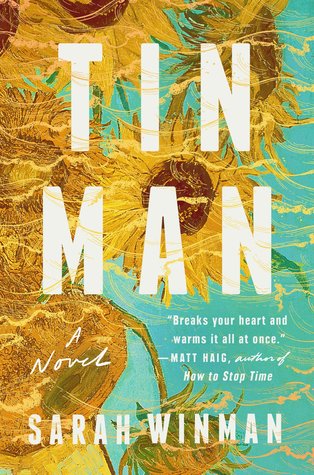 Next, I finished Tin Man by Sarah Winman. This is another compact book, and I really enjoyed it. It is a story of Ellis and Michael, who meet when they are twelve, and develop a beautiful friendship, and deep bond. As the years go on, their relationship changes in a myriad of ways, but they are never far from each others’ minds. Tin Man is a seemingly simple story of their friendship, but is quite profound and bittersweet. It is a beautiful exploration of friendship, love and grief.
Next, I finished Tin Man by Sarah Winman. This is another compact book, and I really enjoyed it. It is a story of Ellis and Michael, who meet when they are twelve, and develop a beautiful friendship, and deep bond. As the years go on, their relationship changes in a myriad of ways, but they are never far from each others’ minds. Tin Man is a seemingly simple story of their friendship, but is quite profound and bittersweet. It is a beautiful exploration of friendship, love and grief.
I then finished A Double Life by Flynn Berry, which I thought was just meh. A Double Life is meant to be a thriller, but I thought it was anything but. You can read my full review here.
I then DNF’d a book, which is rather rare for me. Rust & Stardust by T. Greenwood tells the story of an 11-year-old girl who was abducted and abused for two years. This is based on a real kidnapping that was the inspiration for Lolita. I found the writing really.. juvenile and just meh, and the story itself is just so depressing that I didn’t really want to read over 300 pages about it.
Now for the last three books I read in July! I read My Year of Rest and Relaxation by Otessa Moshfegh, which I adore! I loved her first novel, Eileen, and I loved this one even more. My Year of Rest and Relaxation is about a wealthy college grad living in New York City, who can’t stand her own critical consciousness, and decides she needs a fresh start to see the city, and her own life, in a new light. So she chooses to hibernate for an entire year–self-medicating with sleeping pills so that she only has to be awake for a few hours every day. Moshfegh creates a hilarious, entertaining novel that also picks up on themes of privilege, indulgence, and human connection. I just loved this!
I then read How to Stop Time by Matt Haig, which I thought I would enjoy, but didn’t really. How to Stop Time is about a man who was born with a genetic condition that makes it so he ages one year for every fifteen that he lives. This prolongs the aging process, and allows him to live for a very very long time–he is currently 400-something. I like the idea of time travel, and this was marketed as a love story, so I thought it would be a fun summer read. Instead, I read 300 pages of our main character complaining–about his headaches, how he can’t escape the clutches of this weird society he is in, how he can’t find his daughter, how he can’t get over his wife, who died over 400 years ago, how he can’t fall in love, etc. etc. He also flaunts his historical knowledge at every turn, and just came off as a know-it-all. I did finish this book (the ending was rather expected), but it was just okay, nothing I would recommend.
And if you’ve gotten this far, congratulations!! Finally, I read Into the Raging Sea: Thrity-Three Mariners, One Megastorm, and the Sinking of El Faro by Rachel Slade. I love reading about the ocean and boat disasters, and I remember when this boat sank, so I was eager to learn more. However, while I was reading this, I would tell people about it, and I was surprised at how many people had completely forgotten this had occurred! So I suppose it’s for the best that Slade has written this gorgeous book to keep the memory of El Faro alive, and emphasize the problems with the United States shipping industry. I heard Slade speak about this book on the New York Times Book Review podcast, and her passion for this story was palpable, both in her interview and in this book. She makes what some may consider a dry topic compelling and heartbreaking, offering a glimpse into both the human side of the story, and the industry environment that led to such a disaster. Slade has poured so much time into researching this disaster, coming at it from every angle, and I felt that she left no stone unturned. This is an amazing account of the El Faro disaster, and offers a lot for us to learn from.
Once again, I offer congratulations to anyone who has read this far! I hope you had a great reading month in July, and will have an even better one in August!
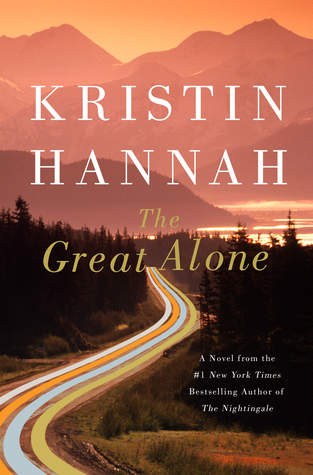 The Great Alone follows a family of three—Leni, and her parents Cora and Ernt—as they move from Seattle to the wilds of Alaska. They are grossly underprepared, yet the small community of Kaneq welcomes them and offers a helping hand. However, Leni’s father, Ernt, is a Vietnam War veteran, and lives with debilitating PTSD that has led him to drinking, and abusive behavior against Leni, and especially his wife, Cora. As the darkness of the Alaskan winter sets in, Leni and Cora face an even darker situation inside their own home.
The Great Alone follows a family of three—Leni, and her parents Cora and Ernt—as they move from Seattle to the wilds of Alaska. They are grossly underprepared, yet the small community of Kaneq welcomes them and offers a helping hand. However, Leni’s father, Ernt, is a Vietnam War veteran, and lives with debilitating PTSD that has led him to drinking, and abusive behavior against Leni, and especially his wife, Cora. As the darkness of the Alaskan winter sets in, Leni and Cora face an even darker situation inside their own home.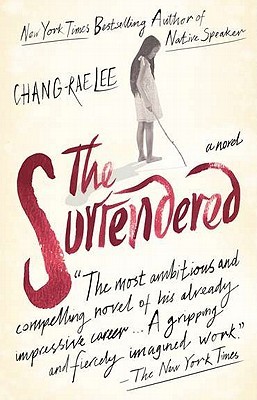 TLDR — I was already so far into this book that when I got sick of it, I just kept going, and now, here I am. Parts of it were good, parts were meh. Lee’s writing was good, and I enjoyed the themes of history and identity woven throughout this book, so I’m curious to read some of his other books, like On Such a Full Sea. The plot and characters just put me off…
TLDR — I was already so far into this book that when I got sick of it, I just kept going, and now, here I am. Parts of it were good, parts were meh. Lee’s writing was good, and I enjoyed the themes of history and identity woven throughout this book, so I’m curious to read some of his other books, like On Such a Full Sea. The plot and characters just put me off…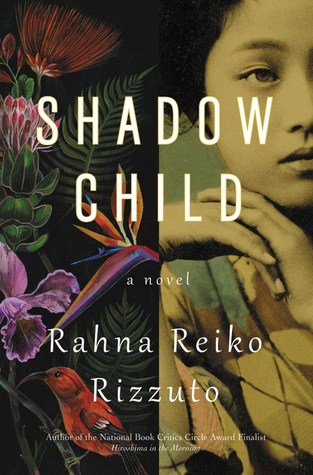 Shadow Child begins with a pair of estranged twins, one in Hawaii and one in New York City. Kei, who lives in Hawaii, travels across the country to visit her sister, Hana, for an unknown reason, which fills Hana with dread. Yet when Hana gets home, ready to confront Kei, she finds her sister has been attacked, and left unconscious in the bathtub. As Hana cares for her comatose sister, she begins to dredge up their past in an attempt to figure out what brought Kei back into her life. The book switches between Hana and Kei, both in the present and past, which can be slightly confusing on its own. However, interspersed with Hana and Kei’s stories, is that of their mother, who is referred to by a variety of names, making reading even more confusing.
Shadow Child begins with a pair of estranged twins, one in Hawaii and one in New York City. Kei, who lives in Hawaii, travels across the country to visit her sister, Hana, for an unknown reason, which fills Hana with dread. Yet when Hana gets home, ready to confront Kei, she finds her sister has been attacked, and left unconscious in the bathtub. As Hana cares for her comatose sister, she begins to dredge up their past in an attempt to figure out what brought Kei back into her life. The book switches between Hana and Kei, both in the present and past, which can be slightly confusing on its own. However, interspersed with Hana and Kei’s stories, is that of their mother, who is referred to by a variety of names, making reading even more confusing.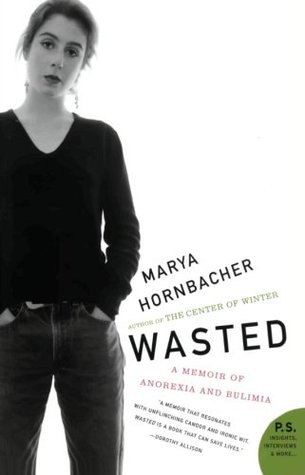 First, I finished Wasted: A Memoir of Anorexia and Bulimia by Marya Hornbacher. I read this for a course called Gender, Culture and Madness, and we discussed eating disorders and how they are mediated by culture. I found this memoir really illuminating and beautifully written. We had previously read Brooke Shield’s memoir about post-partum depression, and that was so poorly written that I had really bleak expectations for any other book we would read in class. However, Hornbacher is a great writer, and offers a really intelligent yet personal look back at her struggle with eating disorders and how she began to recover from them. I have never had an eating disorder, but this book allowed me to develop a deeper understanding of what it is like to experience such an illness. I think this book could be triggering for those who have struggled with eating disorders in the past. It is quite shocking and horrifying to read at times, but I think it is important to grapple with such things, and we shouldn’t look away. However, it is a great introduction for those who are more unfamiliar and want to learn more.
First, I finished Wasted: A Memoir of Anorexia and Bulimia by Marya Hornbacher. I read this for a course called Gender, Culture and Madness, and we discussed eating disorders and how they are mediated by culture. I found this memoir really illuminating and beautifully written. We had previously read Brooke Shield’s memoir about post-partum depression, and that was so poorly written that I had really bleak expectations for any other book we would read in class. However, Hornbacher is a great writer, and offers a really intelligent yet personal look back at her struggle with eating disorders and how she began to recover from them. I have never had an eating disorder, but this book allowed me to develop a deeper understanding of what it is like to experience such an illness. I think this book could be triggering for those who have struggled with eating disorders in the past. It is quite shocking and horrifying to read at times, but I think it is important to grapple with such things, and we shouldn’t look away. However, it is a great introduction for those who are more unfamiliar and want to learn more.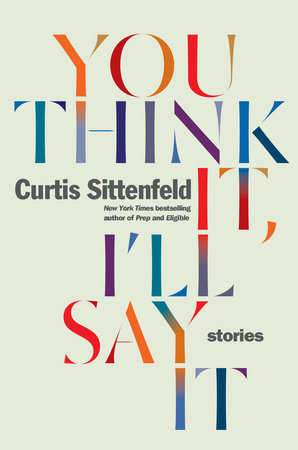 I also really enjoyed You Think It, I’ll Say It by Curtis Sittenfeld. I was first introduced to her writing through Eligible, which I loved, so I was really excited to read her new collection. This is a short story collection that covers themes of love, marriage and friendship, and the surprises one can find in life. I love how Sittenfeld makes the ordinary extremely interesting and engaging, bringing new insights and observations to everyday situations. This is a great collection with varied stories that will keep you engaged–I didn’t find any to lag or bore me. A great new release!
I also really enjoyed You Think It, I’ll Say It by Curtis Sittenfeld. I was first introduced to her writing through Eligible, which I loved, so I was really excited to read her new collection. This is a short story collection that covers themes of love, marriage and friendship, and the surprises one can find in life. I love how Sittenfeld makes the ordinary extremely interesting and engaging, bringing new insights and observations to everyday situations. This is a great collection with varied stories that will keep you engaged–I didn’t find any to lag or bore me. A great new release!
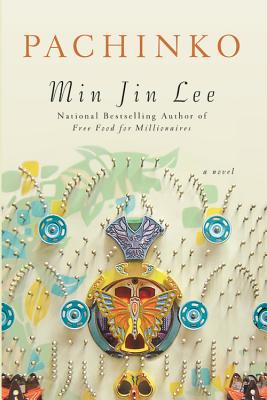 Another novel that focuses on South Korea is Pachinko by Min Jin Lee, which I read in March. Pachinko tells the story of a young girl who is impregnated by a married Japanese man, who refuses to leave his wife for her. However, a young priest comes to her town and agrees to marry her if she will travel to Japan to live with him there. Lee then embarks on a vast family saga which follows a Korean family’s struggle to survive in Japan, where Koreans were discriminated against. Japan colonized Korea from 1910-1945, and accepted Koreans into Japan, but treated them as second-class citizens and forced them to give up their own culture and language to survive in Japanese society. Pachinko gives us a personal view of such struggle, and has opened many eyes to an often overlooked issue.
Another novel that focuses on South Korea is Pachinko by Min Jin Lee, which I read in March. Pachinko tells the story of a young girl who is impregnated by a married Japanese man, who refuses to leave his wife for her. However, a young priest comes to her town and agrees to marry her if she will travel to Japan to live with him there. Lee then embarks on a vast family saga which follows a Korean family’s struggle to survive in Japan, where Koreans were discriminated against. Japan colonized Korea from 1910-1945, and accepted Koreans into Japan, but treated them as second-class citizens and forced them to give up their own culture and language to survive in Japanese society. Pachinko gives us a personal view of such struggle, and has opened many eyes to an often overlooked issue.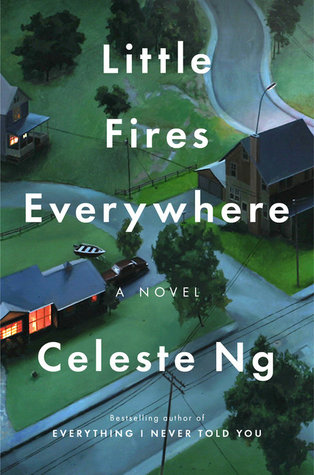 I found a copy of Little Fires Everywhere by Celeste Ng at a yard sale, and I’m so glad I did! I had not yet read her first book when I picked this up, and wow–I was blown away by her writing! Little Fires Everywhere tells the story of two families in a small suburb of Cincinnati and the consequences of each of their actions. Little Fires Everywhere addresses social class, family and privilege in a very thought-provoking manner. I’m so glad I read this, and I am excited to read Ng’s first book.
I found a copy of Little Fires Everywhere by Celeste Ng at a yard sale, and I’m so glad I did! I had not yet read her first book when I picked this up, and wow–I was blown away by her writing! Little Fires Everywhere tells the story of two families in a small suburb of Cincinnati and the consequences of each of their actions. Little Fires Everywhere addresses social class, family and privilege in a very thought-provoking manner. I’m so glad I read this, and I am excited to read Ng’s first book.